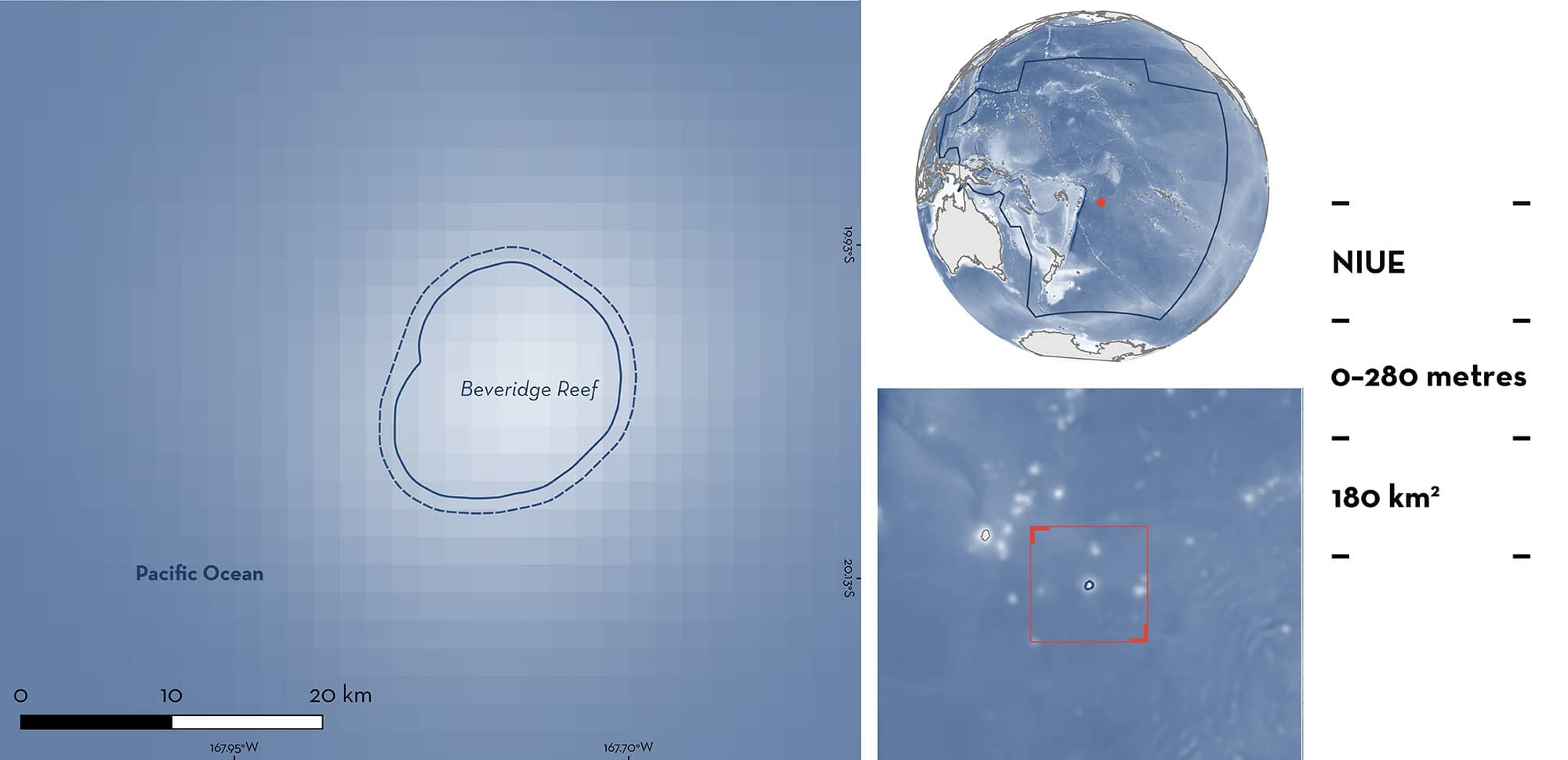ISRA FACTSHEETS
ISRA FACTSHEETS
NEW ZEALAND & PACIFIC ISLANDS REGION
Beveridge Reef
Summary
Beveridge Reef is located 240 km southeast of Niue in the South Pacific Ocean. It is a submerged atoll with emergent land. The area is considered the largest seamount/coral reef within Niue’s exclusive economic zone. The dominant coral genera across depth strata is Acropora sp.. This area overlaps with the Niue Moana Mahu Marine Protected Area. Within this area there are: threatened species and undefined aggregations (Grey Reef Shark Carcharhinus amblyrhynchos).
Download factsheet
Beveridge Reef
DESCRIPTION OF HABITAT
Beveridge Reef is located 240 km southeast of Niue in the South Pacific Ocean. It is a submerged atoll with emergent land. Its summit reaches to within 10 m of the water surface. The area is considered the largest seamount and coral reef area within Niue’s exclusive economic zone. The dominant coral genera across depth strata is Acropora sp. (Thompson et al. 2024). The combined coral coverage of hard coral and crustose coralline algae of the backreef inside the lagoon is 50%. There is 41% coral coverage at 10 m (dominated by Montipora and Porites), and 30% at 20 m (dominated by Astreopora) (Thompson et al. 2024).
This area overlaps with the Niue Moana Mahu Marine Protected Area (Protected Planet 2024).
This Important Shark and Ray Area is benthopelagic and is delineated from surface waters (0 m) to 280 m based on the depth of the Qualifying Species in the area.
CRITERION A
VULNERABILITY
One Qualifying Species considered threatened with extinction according to the IUCN Red List of Threatened Species regularly occurs in the area. This is the Endangered Grey Reef Shark (Simpfendorfer et al. 2020).
CRITERION C
SUB-CRITERION C5 – UNDEFINED AGGREGATIONS
Beveridge Reef is an important area for undefined aggregations of one shark species.
Beveridge Reef is a largely understudied location. Historical reports indicate that Grey Reef Sharks were known to occur in the area (Mead 1990). Only two scientific investigations have been undertaken in the area. Standardised baited remote underwater video station (BRUVS) surveys in 2016 found that Beveridge Reef had the second-highest abundance of Grey Reef Sharks around an uninhabited island in the world (Friedlander et al. 2017; Thompson et al. 2024). BRUVS recorded Grey Reef Sharks in groups of up to 14 individuals (Thompson et al. 2024), with a mean maxN of 5.1 (maximum number of individuals of a species observed in a single frame; Friedlander et al. 2017). At that time, the density of this species in the area was an order of magnitude higher than recorded elsewhere around the world. They were observed on nearly every survey in 2016 and accounted for >33% of total fish biomass (Friedlander et al. 2017). The maxN of Grey Reef Sharks in mid-water BRUVS undertaken in 2016 was three individuals. This infers that Grey Reef Sharks aggregate closer to the seabed in Beveridge Reef. There is additional photographic evidence of Grey Reef Shark aggregations from this area outside of BRUVS surveys (e.g., during a 2016 expedition with 35 individuals recorded together).
In July 2023, 28 benthic BRUVS recorded 175 Grey Reef Sharks, comprising 92% of all observed sharks and rays (Thompson et al. 2024). Grey Reef Sharks were present on all camera recordings, in groups of up to 12 individuals. The mean maxN for this species at Beveridge Reef increased from 5.4 in 2016 to 6.7 in 2023 (Thompson et al. 2024). The abundance of the second-most sighted shark or ray (Whitetip Reef Shark Triaenodon obesus) was sighted at rates more than ten times fewer than Grey Reef Shark. Further, the observations of Grey Reef Shark aggregations in this area were higher compared to nearby locations such as Niue Island (maxN = 1.5) and Antiope Seamount (maxN = 3.33) (Thompson et al. 2024). Grey Reef Sharks were observed on midwater and benthic BRUVS in 2016 and 2023 (Thompson et al. 2024). The presence of Grey Reef Sharks in this area outside the use of bait has been recorded from 17 underwater visual census surveys. In 2023, Grey Reef Sharks contributed the most biomass to those surveys and were observed during each survey (Thompson et al. 2024).
In addition to these surveys, Grey Reef Sharks (including aggregations) have been observed and reported by recreational divers visiting the area over the years (Footprint & Begonia 2017). Also, the underwater visual census surveys undertaken in 2023 recorded several female Grey Reef Sharks with fresh mating scars (Thompson et al. 2024), suggesting the function of these aggregations may be for reproductive purposes. However, further information is required on the regularity of reproductive behaviour to determine the nature and function of these aggregations.
Download factsheet
SUBMIT A REQUEST
ISRA SPATIAL LAYER REQUEST
To make a request to download the ISRA Layer in either a GIS compatible Shapefile (.shp) or Google Earth compatible Keyhole Markup Language Zipped file (.kmz) please complete the following form. We will review your request and send the download details to you. We will endeavor to send you the requested files as soon as we can. However, please note that this is not an automated process, and before requests are responded to, they undergo internal review and authorization. As such, requests normally take 5–10 working days to process.
Should you have questions about the data or process, please do not hesitate to contact us.


